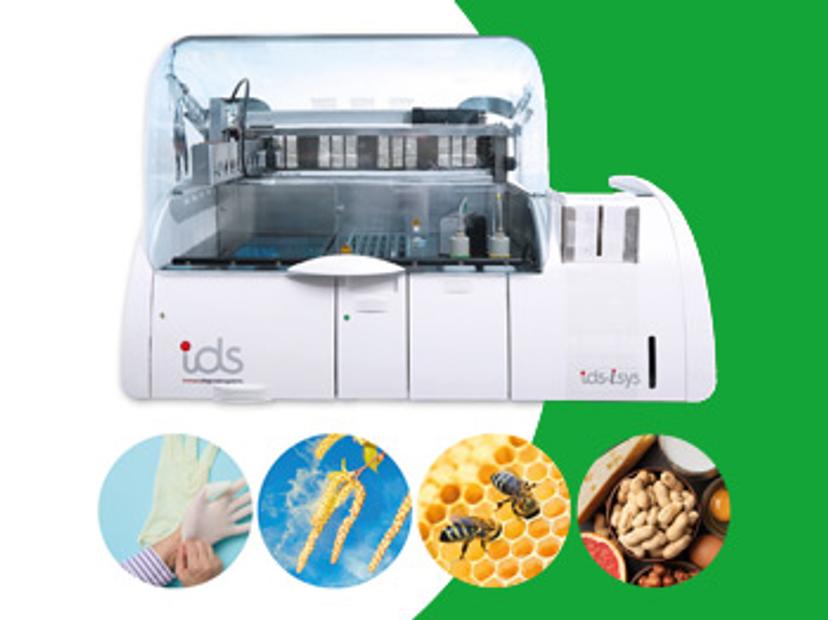United expertise for allergy diagnostics
Euroimmun and IDS offer a complete solution for easy and reliable allergy diagnostics
30 Aug 2024
Chemiluminescence immunoassay (ChLIA) technology on the benchtop IDS-iSYS system enables analysis of specific IgE (sIgE) against the most common allergens
Euroimmun and IDS offer chemiluminescence immunoassay (ChLIA) technology on the benchtop IDS-iSYS system for reliable analysis of specific IgE (sIgE) against the most common allergens.
Up to 40% of the population worldwide is sensitized to one or more normally innocuous substances1,2. Children are especially affected and many individuals are polysensitized. Diagnosis of allergies is based on clinical evaluation, in vivo tests such as the skin-prick test and in vitro analysis of sIgE. In vitro tests enable identification of the precise triggers of allergic reactions, aiding patient management and immunotherapy decision-making.
Common allergy triggers
Food allergy is triggered in about 90% of cases by one of eight food types: eggs, milk and dairy, peanuts, tree nuts, fish, shellfish, wheat, or soy3. Symptoms of food allergy can range from mild oral itching to severe systemic reactions with anaphylaxis. Allergies to insect venoms, for example from wasps or bees, can also trigger systemic reactions ranging from mild skin conditions to fatal anaphylaxis3.
Inhalation allergies manifest with rhinitis, conjunctivitis, and asthma and can be caused by seasonal allergens such as pollen from trees, grasses, or weeds, or by all-year-round indoor allergens, such as house dust mites, animal dander, and mould spores. Allergic rhinitis is estimated to affect 10 to 30% of the population worldwide1.
Allergic reactions to natural rubber latex are a common occupational allergy, for example in healthcare workers or rubber industry workers. Reactions can occur via direct contact with latex or via inhalation of latex particles3.
In vitro diagnostics
Total IgE can be elevated in patients with allergic diseases, and total IgE measurement can provide an initial indication of an allergic disease. Determination of sIgE against defined allergens helps to identify the triggers of an allergic reaction. sIgE tests based on whole extracts of an allergen source indicate if an allergic reaction against the respective substance can occur.
Assays based on individual components enable identification of the precise allergy-causing proteins, aiding discrimination of primary sensitizations from cross reactions. Component-based diagnostics are thus an important aid for decision-making on specific immunotherapy and the necessity of equipping patients with an emergency set.
Random access system
Euroimmun and IDS have combined their expertise in allergy diagnostics and chemiluminescence immunoassay (ChLIA) technology to provide a complete IgE testing solution for laboratories of all types and sizes.
The IgE assays are processed on the compact benchtop IDS-iSYS Multi-Discipline Automated System, which combines efficient walkaway automation with easy operation. The system has a sample throughput of up to 80 tests per hour and the first test result is obtained after less than 40 minutes. Only small sample volumes of 10 μL to 50 μL serum or plasma are required.
Continuous loading (random access) and integrated cooling of the ready-to-use reagent cartridges allows non-stop operation of the system, enabling a flexible and straightforward daily routine. Moreover, the system starts up and shuts down automatically, minimising resource usage.
Automatic barcode recognition of samples, reagents, and consumables ensures complete traceability. The device also offers the option of combining assays from different diagnostic areas in one run to fully utilise existing capacities.
Assay portfolio
The allergy diagnostic test portfolio for the IDS-iSYS includes assays for quantitative detection of sIgE against the most common allergens in food, inhalation, insect venom, and occupational allergies. Assays are based on high-quality extracts or purified molecular components, for example Der p 10, Casein (Bos d 8), Ara h 2, Phl p 1, and Bet v 1.
The food allergy range covers egg, milk, cod, fish and shellfish, fruits, legumes, nuts, and seeds. The inhalation allergy range covers mites, animal dander, moulds, and pollens from grasses, trees, and weeds. Wasp venom, honeybee venom, and latex round off the portfolio. An assay for quantitative measurement of total IgE is also available. Further parameters will be added in the future to extend the diagnostic range.
Service and support
Euroimmun and IDS place great emphasis on reliable service and personalised support for their allergy diagnostic products. Knowledgeable staff are on hand to advise laboratories on the tests and workflow solutions that are best suited to their needs. Intensive on-site support is provided for installation of the instrument and training of laboratory technicians to use it. Annual routine maintenance and upgrades are also included in the service.
Summary
- sIgE against common allergens can be determined easily and reliably using state-of-the-art chemiluminescence immunoassay (ChLIA) technology.
- The high-quality, user-friendly benchtop IDS-iSYS provides reliable and flexible automation.
- Personalized service and support ensure optimal workflows suited to each laboratory’s needs.
References
- World Health Organization. White Book on Allergy 2011-2012 Executive Summary. isir.ru/files/WAO_White_Book-Summary.pdf
- American Academy of Allergy, Asthma & Immunology. Allergy statistics. www.aaaai.org/about/news/for-media/allergy-statistics (accessed July 2024)
- American College of Allergy, Asthma & Immunology. Allergic Conditions. acaai.org/allergies/allergic-conditions (accessed July 2024)
More information on the Euroimmun and IDS allergy portfolio can be found at www.euroimmun.com/allergy-chemiluminescence-immunoassays.
Regulatory status, precise intended use and product availability must be verified for the user‘s individual jurisdiction.
